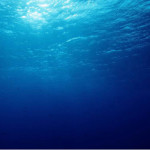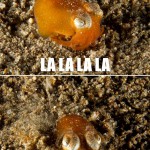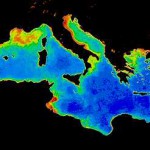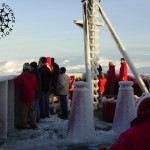Terrestrial biologists have it easy (especially those that work in the tropics) – they can just book a plane ticket and wander around the forest, Tra la la la la, sketching their favorite animal and collecting specimens. Hey, if Wallace could manage it in the 1800s, then it must be a piece of cake. Marine Scientists, on the other hand, are reliant on a ridiculous amount of infrastructure. Your sample site may be a 5 day steam from the nearest landmass. Your animals might live a couple miles below sea level. Polar researchers have it even tougher, because their favorite oceans are covered in ice for half the year.
Maybe if Red Bull funded marine research, we could send a skydiving human icebreaker, whose parachute doubles as an otter trawl and niskin bottle, to crash through polar seas in the winter and collect scientific samples. (Felix Baumgartner, CALL ME!)
No, marine research is funded by government agencies – they hold the dolla$ for the ships. Winter sampling-by-stuntman would be a little too risky for their tastes, and so research in polar regions by default has to happen in the summer (one of the reasons the Antarctic program was almost screwed by the government shutdown). My point? Our knowledge of polar regions is almost exclusively based on research done during ONE season. But according to a recent study, that seasonal bias is really messing with our understanding of biology.
In a badass new paper, Ladau et al. (2013) looked at diversity in bacterial communities around the globe, comparing patterns across seasons, and at the equator versus the poles. Although we generally think of the tropics as “biodiversity hotspots” for larger organisms, bacteria swimming in surface ocean waters are way to hipster to follow such mainstream diversity patterns.

Because scientists always sample high latitudes during summer months, previous data seemed to give the appearance of higher bacterial species diversity in tropical waters. But this isn’t actually true! The bacteria all go party at high latitudes in the WINTER – you know, that time of year when there are NO SCIENTISTS doing any sampling. Bacterial diversity shows huge, seasonal winter peaks (in December at temperate and high latitudes in the Northern Hemisphere, and in June at temperate latitudes in the Southern Hemisphere), making tropical biodiversity look pretty LAME in comparison.
Ladau et al. used a modeling approach to compensate for the persistent sampling bias in time and location – they were able to extrapolate the predicted species distributions of bacteria based on real environmental datasets (rRNA genes sequences). They pummeled the data from every possible angle – changing models, changing parameters, subsampling their data, using other datasets, and even looking at error rates. Nothing could mess with their results – the predicted biodiversity patterns stood up to every kind of test.
Why does bacterial diversity show seasonal peaks during the wintertime in both hemispheres? We’re still not sure, but it might be due to vertical mixing which brings nutrients (and species?) to the surface. Another theory is that bacteria could migrate across latitudes. Models are no substitute old fashioned fieldwork, but they’re important for letting us look at biology from a different perspective. In this case, it shows we need to collect way more wintertime samples.
Reference:
Ladau J, Sharpton TJ, Finucane MM, Jospin G, Kembel SW, Dwyer JOA, et al. (2013) Global marine bacterial diversity peaks at high latitudes in winter. The ISME Journal, 7:1669–77.







4 Replies to “Hipster bacteria hate the tropics (it’s too mainstream)”
Comments are closed.